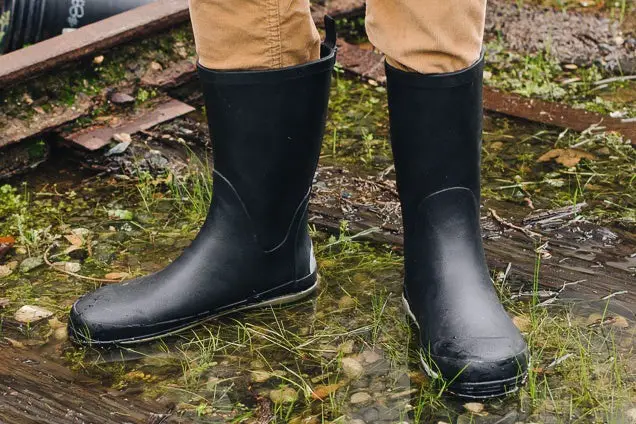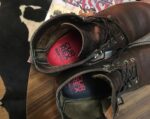Rain Boots are among the most preferred choices for people in the winter and rainy seasons due to their water-resistance qualities and sustainability.
While the rubber material tries to adjust to the changing weather conditions, it also changes that it expands or contracts, especially in the portion covering your calves.
This re-adjustment might create discomfort while walking too. Another instance where you might have to negotiate with unfitting calves for your rain boots is when you like a boot but do not buy it just because it is not comfortable for your calves.
If you face confusion like this, we will encourage you to go and buy the boots as we have found a solution for you to tackle the situation.
There are multiple ways of stretching the calves of your rain boots. Drying methods, freezing method, using calf stretchers or stretching spray, wearing thick socks, moist-heat method, etc. If none of these works, we always have a cobbler for rescue.

Pulling them to enlarge can give you much more comfort than wearing a tighter calves boot. The material rubber also tends to undergo wear and tear with the changing weather.
Stretching your calves and boosting their elasticity will also help sustain the boot for a longer time. This article consists of some cost-effective and easy methods that you can use to stretch the calves of your rain boots.
1. Freeze Your Rain Boots
The shoes can be frozen so that it expands and fits the size of your calves well. However, this does not mean that you simply keep it in an ice pack or inside the refrigerator. There is a systematic way to freeze your rain boots to stretch them for your calves.
Procedure:
1.) Pour some cold water into a ziplock bag and place it inside the boots.
2.) After placing it in the correct position, keep it in the freezer overnight so that the water transforms into ice and expands the shoes.
3.) Remove the ice pack formed inside the Ziploc bag.
4.) Try the boots with thick socks and check if it fits.
5.) If not, repeat the procedure multiple times until you receive the desired results.
Pros:
The freezing method is easy to use and does not require you to buy anything new from the market. All you need is a little cold atmosphere and a ziplock.
Cons:
One con of this method is that it might take more time if you want to stretch it a lot. You might have to repeat the procedures multiple times to achieve the desired results. There can be problems if the Ziploc is not filled adequately or overfilled.
2. Use a Calf-stretcher
In this method, an external force is applied using the calf stretcher to expand the calf area of the boots. A lot of people prefer this method due to the benefits that it provides.
Find yourself a calf stretcher that is the most appropriate for your shoes, and it can turn out to be a wise one-time investment.
Procedure:
1.) Insert a calf-stretcher into the shoes.
2.) Pull the boots with the stretcher inside to expand near the calf area.
3.) Leave it in the shoes for a certain amount of time.
4.) Remove the calf stretcher and check if it has been adjusted.
5.) If not, then repeat the procedure.
Pros:
It does not have any other side effects and is commonly used for stretching calves. It also does not require much manual and continuous effort like other procedures. It gives long-lasting benefits.
Cons:
It might take more time than other procedures. However, they give away their resistance with the constant use of calf-stretchers. Be patient with the process to see maximum results.
3. Drying your boots with a blow dryer
Have you ever thought about the connection between rain boots and hairdryers? If you believe that they do not have any relation, this method will change your perception.
A hair dryer can be an excellent tool to stretch the calves of your rain boots as it helps you retain the shape of your shoes and avoids the change in the shape that might happen due to weather conditions.
Procedure:
1.) Combine a pair of thick cotton socks with your boots and wear them.
2.) Blow-dry the part that needs to be stretched for about 20-30 secs at a medium heat adjustment.
3.) Hover the dryer above the parts that need to be adjusted.
4.) Keep moving your feet in directions so that it is effective holistically.
5.) Try to wriggle your feet inside the shoes to ensure more expansion.
6.) Walk around with those shoes so that they cool down.
7.) Remove the socks, try wearing them again, and repeat the procedure until the desired results are achieved.
Pros:
A blow dryer is readily available in most households and is easy to use. It takes less time compared to other methods.
Cons:
Exposure to heat might not always be safe for the rubber material. Thus, blowing heat for a long time or increasing the heat can wear and tear the boots.
However, keeping it on a low or medium heat for the prescribed amount of time can keep the boots safe and help you with the required expansion.
4. Insert Moist-heat bags
Like the freezing method, the water bag is frozen to turn into ice. Here the water bag is heated and then kept inside so that it cools down and helps the rubber expand as the heat is passed on to the material.
Procedure:
1.) Fill Ziploc bags with hot water and place them inside the boots near the calf area. Keep them in whichever area you want them to be extended.
2.) Allow them to cool inside the boots.
3.) After removing the cool bags, fill them with socks to obtain the required stretching.
4.) After that, place the boots in the microwave or oven for a short span and take them out.
5.) Let the boots cool before you try them on.
Pros:
It is safer than the dry heat method. It also gives better results and does not lead to much wear and tear on the boots.
Cons:
Irrespective of whether it is dry or moist, heat can be harmful to your boots if not in an appropriate amount. Thus, care should be taken while exposing it to heat.
5. Use other tools
Like a calf stretcher, there are other tools available in the market or online that can be used to stretch. Stretching liquid is one of them. They can be bought from shops or made at home.
If you are planning to make it at home, you need to mix alcohol with warm water at a ratio of 1:1. Fill the liquid in a bottle and spray some amount on the part of the shoe that needs to be expanded. Spray it on the inside as well as outside of the boots.
Another such tool is the shoe tree which is one of the oldest methods used to stretch the calves. It usually works on the length and width of the boots but does not change the shape of the boots much.
Make sure to spray the dilator on the shoes before using a shoetree. However, it almost works like a calf stretcher, an old tool that shoemakers commonly use.
Using wet newspaper balls to insert in the boots to fill them and expand them is also one of the most accessible home remedies that can also be used.
However, make sure that you remove all the newspapers correctly and that none of them remain stuck in the boots. Keep them out for air dry before wearing them.
Keep massaging and relaxing the shoes, and stretch and wriggle inside the foot to expand the calf area. Most importantly, wear them as much as possible, as wearing and walking plays a huge role in the expansion of the boots.
6. Seek help from Cobbler
If you feel that none of these methods work for your shoes, seeking professional help will be the wisest option. Even if you need to make a considerable adjustment, home remedies might not always help.
Let the cobbler know the correct amount of changes you expect with the adjustments. Their skills will help you have comfortable and perfect shoes.
Conclusion
You need not worry about what you have to do with your shoes whose calves are tight or uncomfortable. There are so many methods that you can use to rectify them before having second thoughts about discarding them altogether.
Most home remedies come with a certain amount of pros and cons. Ensure that you are aware of all of them to make an appropriate decision based on which one will suit your shoes the most.
Calves are one of the essential parts of your feet that should be comfortable to have a smooth walk. Hence, you mustn’t take them lightly and pour in efforts to maintain them.







